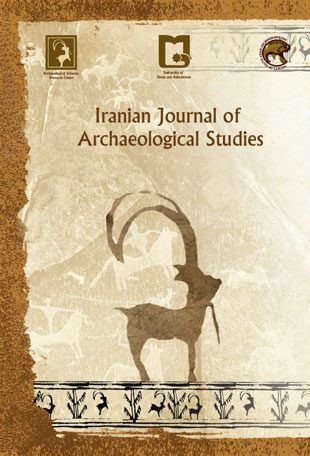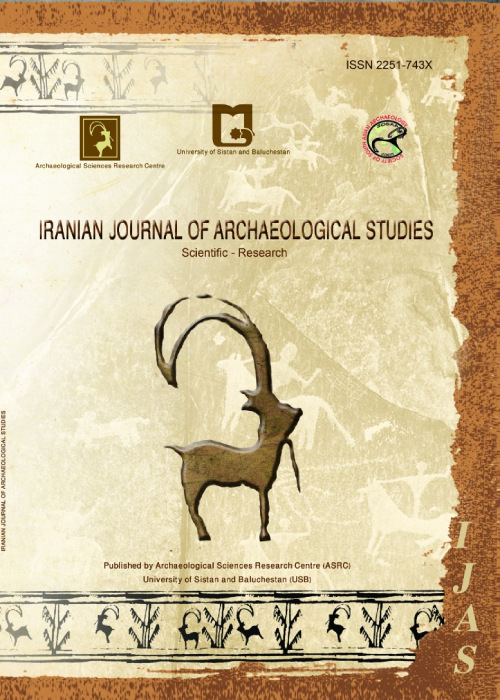فهرست مطالب

Iranian Journal of Archaeological Studies
Volume:1 Issue: 2, Summer and Autumn 2011
- تاریخ انتشار: 1392/03/03
- تعداد عناوین: 7
-
-
Page 1Plant remains from archaeological sites reflect many aspects of the relationship between people, plants, and the environment in which they lived. Plant macroremains—seeds and wood that are visible without a microscope—can address a wide range of questions. The most basic include what crops were grown? What was used for fuel? Do any of the plants come from distant lands? Examples from fourth and third millennium deposits at Farukhabad, Sharafabad, Godin, and Malyan show that within the basic agricultural assemblage of wheat and barley shared by all sites, Sharafabad and Godin have stronger evidence of irrigation, lentil and flax, and Farukhabad appears to be more oriented toward pastoral production than the other sites. This article provides an introduction to archaeobotany using examples drawn from several fourth and third millennium sites in southern and western Iran. Human impact on the vegetation in Khuzestan and Fars appears to have been minimal at this time. A few unexpected finds (a date pit from cold-country/Sardsir Malyan suggests trade and rice at Parthian Susa may be evidence of a new crop that had long been cultivated in the Indus valleyKeywords: archaeobotany, agriculture, Sharafabad, Farukhabad, Godin, Malyan
-
Page 9Two vessels from different sites of the Iranian Plateau, dating to the late 4th or early 3rd millennium BCE are presented as palaeotechnological case studies. In the fractures of the vessels’ walls, interfaces left by added clay parts (enhanced in the two illustrations) are quite recognizable. It is proposed that in both cases potters, in order to construct the bases, used to make bowls comparable with two types of finished containers common in their repertories (respectively, a moulded bevelled rim bowl and a coil-built truncated-cone shaped one with a distinctive pointed rim). As a working hypothesis it is suggested that making open vessels to build on the rest of the vase was a technical template, possibly shared in the late 4th millennium across different regions of the Iranian Plateau. Scholars are encouraged to record the sections of their vessels showing joins among coils and other interfaces, as this palaeotechnological evidence is potentially very useful in assessing the historical meaning of wide “interaction spheres” traditionally considered only in terms of traditional ceramic morphological comparisons.Keywords: Vessel, 4th Millennium BC, Iranian Plateau, Ceramic technology
-
Page 17We had the opportunity to examine the cranium of a young woman found at the well-known Neolithic site of Ali Kosh on the Deh Luran plain in southwestern Iran. It has previously been claimed that her head shows traces of modification, a practice which can be termed as either cultural or artificial cranial modification. Here, we describe several macroscopic characteristics of the modified crania and discuss how this claim can be dismissed. Our craniometric study of the Ali Kosh cranium showed that the morphological state of that cranium is analogous to that of the crania of modern humans. A comparison of the morphological change patterns of deformed crania and development of wormian bones with that of Ali Kosh suggest that the Ali Kosh cranium is not the result of artificial head deformations.Keywords: Artificial or cultural modifications, Ali Kosh cranium, Cranial morphological change, Wormian bones
-
Page 25Shahdad and Yahya which are two important prehistoric sites in the Kerman Province, are of most important for Archaeometallurgical studies. During excavations at these sites a number of metal objects have been discovered. Moreover, evidence of metal working on the surface testify to manifacturing of metal objects. This also shows that the site might have experienced craft specialization. The following contribution is representing results of archaeometallurgical investigations on several metal artifacts from prehistoric contexts from the sites of Tepe Yahya and Shahdad which are situated in Kerman Province. The aim of this research is to investigate the provenance of the raw materials which had been used. Further some new observations concerning the distribution of artifacts will be presented.Keywords: Bronze Age, Shahdad, Tepe Yahya, Ur, Metal Artifacts
-
Page 35The archaeological mound of Sofalin south of the Alborz Mountains of Northern Iran (Eastern Rey plain) sheds considerable light on at least four problems connected with the emergence of complex societies in this part of Iran. The first, it helps fill a chronological gap in an important archaeological sequence by revealing a previously unidentified late fourth and third millennium B.C. sequence of occupations. Second, the remains recovered from the mound illustrate a surprising sophistication in the use of proto-Elamite economic and numerical tablets, as well as cylindrical seal impressions. Third, it shows an early stage of an administration system in this area which has not been identified before. Finally, the data may reflect a development from a rather generalized subsistence economy based on agriculture to an economy based on longdistance trade connected with the import and export of goods.Keywords: Tape Sofalin, Central Iranian Plateau, Late Plateau, Proto Elamite, Tablets, Seal Impressions
-
Page 49Tepe Sagzabad, a site situated on the Qazvin Plain of north-central Iran, was excavated from 1970 to 1998 by the Institute of Archaeology of Tehran University. Recent excavations by H. Tala’i (1997-1999) yielded some metal artifacts dating to the Early Iron Age. Ten of these copper-based samples were investigated using inductively coupled plasma optical emission spectroscopy (ICP-OES), scanning electron microscopy combined with energy dispersive X-ray spectroscopy (SEMEDX) and optical microscopy (OM). The results of these analyses showed that the metal objects at Tepe Sagzabad are made of different copper alloys, including: pure copper, copper-arsenic and copper-tin. In addition, multiple procedures, including hot-working, cold-working, and annealing were used as manufacturing techniques. The copper-based objects from Tepe Sagzabad provide evidence for the continued use of pure copper and arsenical copper alongside tin bronzes on the Iranian Plateau during the Early Iron Age.Keywords: Sagzabad, Qazvin Plain, Iranian Plateau, Archaeometallurgy, Copper alloys, Iron Age
-
Page 61This paper deals with pottery assemblage from the chalcolithic phase of the site of Gilund in Rajsamand district of Rajasthan. Though pottery from this site has been studied earlier (Shinde et al 2002), however there was no literature available on the ceramic chronology of Gilund with layers ascertained to it. This paper tries to build up a ceramic chronology in the site in order to indentify different phases in the chalcolithic period and ascertain layers to these phases. It further attempts to put forward certain developmental trends and characteristics of chalcolithic pottery for the site of Gilund with probable functional interpretations.Keywords: Chalcolithic, Ahar, Banas, Gilund, Pottery, Rajasthan


